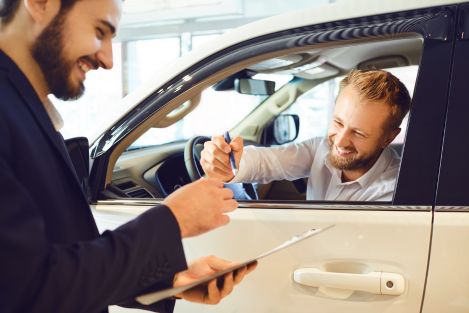
Written by Kayla Jane Barrie Updated on Feb 25, 2025 5 mins read

Are you wondering how tax works when you purchase a used car?
Much like new vehicles, used car purchases come with additional fees, including sales tax. Whether you are selling a vehicle privately or looking to buy a used car, it’s essential to understand how tax works on used vehicles.
When you purchase a used car in Canada, the sales taxes you pay may differ based on your location and the nature of the transaction. Depending on where you live, you may be subject to luxury tax, provincial and federal sales taxes, or no taxes at all.
To help you understand what you're responsible for paying, here's a breakdown of the sales taxes you'll need to pay in Ontario when you buy a used car.
You may have heard buyers in the province don’t pay tax on a pre-owned vehicle. This isn’t exactly the truth.
The truth is, you will need to pay the 13% HST as you would with other purchases. However, it’s called an RST (retail sales tax), and it is paid differently. Sellers and car dealers include this tax in the bill of sale. Private buyers pay it later when registering the car. Tax is calculated on the higher value between the purchase price and wholesale value.
When buying a used car from a dealer, you must pay both the federal sales tax (GST) and the provincial sales tax, the same way you would if you were purchasing a new car.
For instance, in Ontario, you must pay the 13% HST, a combination of 5% GST and 8% PST. For example, if you buy a $10,000 2011 Ford Focus in Ontario, you must pay $1,300 in HST. Of this amount, $500 goes to the federal government, while $800 goes to the province.
If you buy a vehicle from a private seller, you will receive a bill from ServiceOntario when you register it. The amount you are billed will be determined by either the purchase price or the Canadian Red Book wholesale value - whichever is higher. Red Book utilizes CARFAX Canada's data to provide three vehicle values: Retail, Wholesale, and MSRP.
If you think the vehicle's value is lower than the Red Book value, you can have it professionally appraised. Once you have an appraisal, you will be billed based on the lower figure. RST will be applied to this amount.
Your bill of sale will outline the taxes and purchase price (taxes collected and HST/GST number if applicable).
Some exemptions might apply when transferring a vehicle to a family member as a gift. In Ontario, the process involves the submission of a Sworn Statement for a Family Gift of a Used Motor Vehicle. This form can be accessed online at ServiceOntario.ca or obtained in person.
The Family Gift exemption is designed to facilitate the transfer of a used motor vehicle between family members without imposing certain taxes that might typically accompany such transactions. This exemption recognizes the familial nature of the transfer and aims to make the process more straightforward for those involved.
When completing the Sworn Statement for a Family Gift, make sure you have the necessary information:
Here is how to get the form and do the process online:
If you prefer to go in person, the process is quite similar:
When purchasing a used vehicle in Ontario, sales tax must be paid under most circumstances, such as if you buy the vehicle from a dealership or privately. There are a few instances where you may not need to pay sales tax.
Don’t forget you’ll need to pay a vehicle permit fee, potential licence plate fee, and other costs associated with owning and driving a vehicle.
When buying a used car from a private seller, you must pay Retail Sales Tax (RST) while registering the vehicle at ServiceOntario. RST is calculated based on the higher value between the purchase price and the wholesale value determined by the Canadian Red Book.
If the Red Book value exceeds $1,000, RST will be based on the purchase price. If the car is excessively used or damaged, get it appraised. If the appraised value and purchase price are less than the Red Book value, RST will be based on the higher value. If you buy a vehicle from another province and bring it back to Ontario, RST will be based on the purchase price.
Here is an example:
You go to purchase a pre-owned vehicle for $15,000. The tax on the vehicle is 13%.
The total cost would be $15,000 + 13% =$16,950.
You can't avoid taxes on used cars, but you can reduce them. Trading in your car for a new one can save you money on taxes. However, there may be better options than this if you're trading in a car with negative equity. Some better options include a lease take over or switching your car in for a lease.
When you register your antique or classic car in Ontario, you must pay 13% RST. This amount will be based on the purchase price, appraisal value, or vehicle replacement value, whichever is the highest amount.
The luxury sales tax is only charged on new cars meeting the minimum retail sales price ( $100,000 and above) and still needs to be registered. Used car buyers wouldn't have to pay this tax if it was paid at the original purchase.
For any vehicle you buy out-of-province, you must pay the sales tax relative to the province you live in. So, if you reside in Ontario and buy a car in Manitoba, you need to pay the tax (13%) in Ontario.
Buying a used car in Ontario? Be informed to avoid financial surprises. Understand HST implications and exemptions, verify tax details with the seller, and seek professional advice if in doubt. If you have any questions about car insurance in Ontario, our brokers are here to help.
| Categories | Auto |
|---|---|
| Tags | Buy and Sell Vehicles |
Read our insurance blog to get helpful tips, information and news.
Has your car been totalled in an accident? Is your car a write off? Learn about vehicle write offs for a total loss insurance claim.
Get the facts on Toronto's auto theft problem. We break down the data, reveal the most-stolen vehicles (including the Honda CR-V and Lexus RX 350), and show which neighbourhoods are most affected.
Dive into the world of auto theft with our blog on the most stolen cars in Canada. See the most stolen cars across Canada, including provincial lists for Ontario and Quebec, and learn how high-risk models can affect your car insurance premiums.
Drive safe this winter! Check out these tips for driving in snowy and icy conditions in Ontario. Get other helpful info and FAQs on winter driving.